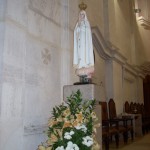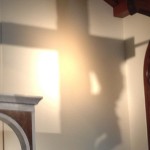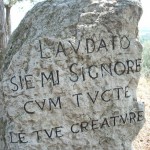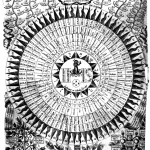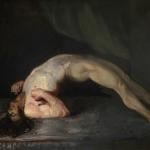First Sunday of Lent
Station at San Giovanni in Laterano
Trivia question: What’s the pope’s cathedral? Hint: It’s not St Peter’s, and it’s older and ranks higher (as the Church’s only archbasilica) than the iconic basilica located within Vatican City.
As Bishop of Rome, Benedict XIV–like all popes preceding him, back to to the fourth century, except during that unfortunate papal getaway to Avignon–hangs his episcopal miter and takes a seat in his cathedra at the Cathedral Archbasilica of the Holy Savior and of Saints John the Evangelist and John the Baptist in the Lateran, or St. John Lateran for short. On this first Sunday of Lent, this is the traditional Roman station church, and visiting it in spirit (as I have had the great gift of doing in person) provides an opportunity to reflect on the twisted history of Church and State that plagues us (OK, me) today.
This oldest of Rome’s major churches, according to tradition, is a souvenir of that fateful first date between the Roman Emperor Constantine I and Christianity, Constantine’s victory at the Milvian Bridge in 312 CE. Whether truth or spin as carefully crafted as the Iwo Jima flagraising photo, Constantine’s choice to adopt the Christian chi-rho as his battle standard–purportedly based on his dream of a cross in the sky, with the device In hoc signo vinces (“In this sign you will conquer”)–resulted in the Edict of Milan, easing of the last legal restrictions against the practice of Christianity in the Empire. A few decades later, Theodosius I went even further, and like an in-his-dreams Rick Santorum decreed Christianity as the state religion and outlawed the practice of paganism. The echoes of that first date down the centuries have shaped Europe and the lands colonized by Europe, for great good and for admitted and terrible ill (cf James Carroll’s Constantine’s Sword: The Church and The Jews, for just one impassioned and well-documented case) ever since.
In that first flush of his romance with Christianity–which most certainly had some of the same cynical, pragmatic motivation that political candidates bring to Bible-thumping today–Constantine bestowed gifts on his beloved. The Lateran palace, a property belonging to the Emperor’s second wife, Fausta, was one of the first of these, like flowers sent to say, “Had a great time at the Milvian Bridge, sweetie. Can I call you this week?” (And yes, the comparison to a mob guy stealing his wife’s jewelry to lavish on his mistress is disconcerting.) Pope Miltiades, then the Bishop of Rome, moved into the Lateran palace, held a synod of bishops there in 313, and by 324 had made it his cathedral, baptizing it Domus Dei–“God’s house.”
The archbasilica grew up gradually next door to and around the palace, on land that once held the army stables of Maxentius, whom Constantine defeated at the Milvian Bridge. (“I build a church on you, and the horse you rode in on!”) It has gone through a number of iterations, its fortunes and its architecture rising and falling with natural disasters and the disastrous ups and downs of ecclesial and imperial relations. (An earthquake did serious damage during the 9th century just as one pope convened a synod to exhume, try, convict, and desecrate the corpse of a previous pope–proof that Church can do be as hard on Church as State can, I guess.)
The basilica’s great west door was once the entrance to the Roman Curia, or Senate chamber. Its labyrinthine marble floors were designed by the workshops of the Cosmati family, and date from the 14th century. The coffered ceiling, restored in the 18th century, contains some of the first gold brought back to Europe from the Americas by Columbus. When Pope Innocent III, at first reluctant to grant the Crazy Man from Assisi’s request to start a religious order, dreamed that Francis singlehandedly saved the Church from collapse, it was this physical church he dreamed of. Today, Christ and his Apostles (or, as I was sure our wonderful Italian guide Fedora was calling them, Jesus Christ and The Applesauce) look down impassively from the apse mosaic at a vast expanse of filigree and statuary and tourists snapping cellphone photos.
San Giovanni in Laterano is beautiful, in the over-the-top, grand opera Baroque way that began to give me Bernini hives after a while. The Church is like that. She’s dropdead gorgeous–you can see why Emperors swooned even back when she was just wearing off-the-rack plaster catacombs–but despite her own sound teachings, she doesn’t always marry well. Too close a series of dynastic nuptials with the crowned heads of Europe gave her a taste for earthly power that makes the whole world break out in hives on occasion.
That’s worth remembering as a cautionary tale in this first week of Lent, when we have welcomed home from Rome one American churchman with the new state title and rank of Prince, God help and save him. When we are engaged in what both sides insist on framing as the Battle of the HHS Bridge, to decide (if such a question can ever be decided) not how Church and State are to coexist, but which will eradicate the other from American life. When we have yet more proof that Church leaders have colluded sinfully to evade State consequences for the abuse of children. I love my Church, but weeks like this, she makes me itch something fierce.
That’s why it’s also good to come home, to my own station church, my parish. Not a glittering filigree or a Cosmatesque curlicue in sight. Just baby bottles to collect our parish Lenten almsgiving in support of Elizabeth’s New Life Center. Announcements of Sunday afternoon Adoration and Friday night Stations of the Cross. A child cantor’s treble leading us in singing God’s promise to Hosea’s worldly wife Gomer (God’s promise to the Church in her–our–unfortunate flirtations with earthly power), “The wilderness will lead you to your heart where I will speak.” And Fr Tim reminding us, in only a few more, that Jesus’ first and most compelling sermon was only 19 words long:
This is the time of fulfillment.
The kingdom of God is at hand.
Repent, and believe in the Gospel.
Ah, that soothes the itch.
(Note: Photos of San Giovanni in Laterano are my own poor ones, with thanks to the Vanderburgh Family for the chance to be there.)






